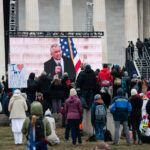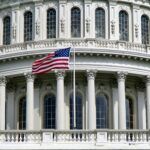As election looms, Trump adds to the long story of conspiracy theory in US politics
By Matt Field | October 28, 2020
 Illustration Credit: Matt Field.
Illustration Credit: Matt Field.
In 2016, University of Miami political scientist Joseph Uscinski tried to imagine a conspiracy theorist as president, someone “sitting at the most powerful desk in the world, complete with the codes to a nuclear arsenal.” By the time Uscinski put his thoughts in writing, Donald Trump was the front-runner in the Republican primary. Trump the candidate had already said refugees fleeing the Syrian civil war could be a secret terrorist army. He’d already claimed there was a link between autism and vaccines. And he’d even hinted that Supreme Court Justice Antonin Scalia might have been suffocated by a pillow. While Trump hadn’t yet accused his opponent’s father of being connected to the JFK assassination, Uscinski had already got the idea: This isn’t good.
Since his election, Trump has continued to plug conspiracy theories, claiming, for instance, that the 2020 presidential election is rigged and that his opponents are criminals. He has even dipped his toes into the murky waters of QAnon—the bizarre theory that prominent elites like Hillary Clinton not only run the world, but have also found the time to operate a Satan-worshiping pedophilia ring. Earlier this month, Trump retweeted an unhinged conspiracy theory about former Vice President Joe Biden baselessly asserted by an account linked to QAnon.
Trump, like no other president in recent memory, is a card-carrying conspiracy theorist. “There’s no reason for people to act shocked,” Uscinski said. “Where the f— have you been for 10 years”?
But questions remain: What’s in it for a sitting president, the keeper of the flame of 231 years of American democracy, to signal-boost some of the worst bilge sloshing around the internet?
QAnon is not popular; until recently, it was barely known.
A recent Pew Research Center poll found that about 50 percent of the public has heard of the theory. While that figure is up from roughly 25 percent earlier in the year, among those who’ve heard of QAnon, three quarters view it negatively. In his surveys, Uscinski has found people rank QAnon in the low 20s on a 101-point scale of favorability, a poor showing.
Barring the possibility that Trump actually believes QAnon’s plotline—he’s passed up big moments to disavow it—Uscinski points to a possible rationale for the president’s embrace of conspiracy theories.
QAnon believers are smack-dab in the middle of Trump’s target constituency of “conspiracy-minded people who don’t like the establishment,” Uscinski said. In 2016, Trump famously told the audience tuned into the Republican Convention in Cleveland, “I alone can fix it.” Trump is still running as an outsider facing off against a corrupt political class, this time as the incumbent.
“What he’s doing is continuing to reach out to these conspiracy-minded constituencies,” Uscinski said. “And even though QAnon might be relatively small, he feels like he’s not going to pay a price for reaching out publicly.”
Despite QAnon’s small following, political scientists like Uscinski think conspiracy theory belief is exceedingly common. Everyone, he said, believes in at least one.
Eric Oliver, a University of Chicago political scientist, has conducted public opinion surveys for the past 15 years on conspiracy theories. In the surveys, he asks people whether they believe in theories like the one about vapor trails behind airplanes being evidence of a secret government spraying campaign or another about the US Food and Drug Administration withholding knowledge about natural cures for cancer. About half the public believes in at least one of the six or seven theories he asks about, Oliver said.
“That leads me to believe that that kind of conspiratorial ethic, that way of understanding or deciphering political information by using reference to a conspiracy theory, is pretty common,” he said.
In a famous piece in Harper’s Magazine, “The Paranoid Style in American Politics,” Pulitzer Prize-winning historian Richard Hofstadter wrote in 1964 about how a sense of loss undergirds political conspiracy theory. Although Hofstadter said that the political “style of mind” that saw vast conspiracies everywhere wasn’t “necessarily right wing,” he paid special attention to the rhetoric of the anti-communist right. The modern right wing, he wrote, believed “America has been largely taken away from them and their kind.”
Conspiracy theories often emanate from the losing side in political struggles. In one study, Uscinski and a colleague surveyed 120,000 published letters written to the editors of major newspapers dating back to at least the 1890s. When a Republican was in the White House, 16 percent of letters that promoted a conspiracy theory focused on right-wing conspiracies. When a Democrat was in power, that figure dropped to 5 percent. The numbers were essentially reversed when it came to letters alleging a left-wing conspiracy. The general pattern, Uscinski wrote in his 2016 article, is that the out-of-power party accuses the in-power party of conspiring.
For much of his term, however, Trump and his side have been the winners on the political battlefield. He’s the sitting president, after all, and Republicans have controlled the Senate for Trump’s entire term and the House of Representatives for half of it.
Despite this strong political position, Trump often paints a grim picture for his supporters.
“As we meet here tonight, there is a growing danger that threatens every blessing our ancestors fought so hard for,” he told a crowd at a July 4th celebration. “Our nation is witnessing a merciless campaign to wipe out our history, defame our heroes, erase our values, and indoctrinate our children.”
In Trump’s telling, his supporters are under threat–at constant risk of losing a great deal. A “left-wing cultural revolution” had overtaken the country’s schools, the news media, and the summer’s racial justice protest marches. “If you do not speak its language, perform its rituals, recite its mantras, and follow its commandments, then you will be censored, banished, blacklisted, persecuted, and punished.”
Conspiracy theories have cast a shadow over American politics, “since almost the beginning,” Ray Smock, a former historian for the US House of Representatives, said. In the middle of the 19th Century, for instance, the American Party, known for its ferocious xenophobia and for its anti-Catholic conspiracy theories, once held more than 100 seats in Congress. The party sprung from the members of secretive nativist organizations who were known for saying they “know nothing” whenever they were asked about their groups.
A hundred years later, the country—grappling with the advent of a nuclear weapons arms race with the Soviet Union—was in the throes of Cold War anti-communist hysteria, an era partly personified by Sen. Joseph McCarthy, a Wisconsin Republican. McCarthy rose to fame after a speech in Wheeling, West Virginia, in 1950 in which he claimed to have the names of 205 communists in the US State Department. The conspiracy theory about communist infiltration touched a nerve with an anxious public.
“We were entering the nuclear age; 1945 was the first time anybody had heard of an atomic weapon,” Smock said. “By 1950, everybody was scared to death that these things could annihilate the world—and the Soviet Union had them.”
McCarthy, of course, became known for the congressional hearings he staged in order to ferret out supposed communists. There in fact were communists in government, but not in the kind of numbers McCarthy touted, Smock said. “He never discovered any communists in government, even though there probably were some. But he had created this hysterical movement that did damage lives.”
McCarthy as a political phenomenon didn’t last long. After he tried to expose communism in the military, the public turned on the senator. He died in 1957. But the hysteria he helped fuel, in part through conspiracy theories, lived on.
“I would argue that McCarthy and many others were responsible for a great influence, an unfortunate influence,” Smock said. “The paranoia became so pervasive you could not hardly run for office unless you had expressed anti-communist views. In those days, if you even suggested that ‘well maybe the Soviet Union had its good points’ or ‘maybe we shouldn’t be so worried about the Soviet Union,’ you were called a comsymp, a communist sympathizer.”
The fear of communism affected both parties. President Lyndon Johnson, a Democrat, “bought into the Domino Theory that if we didn’t fight the communists in Asia we’d be fighting them in California. “ Smock said. “The whole Vietnam era is sort of the ultimate expression of anti-communist fear.”
It’s hard to say the Red Scare period was marked by a particular prevalence of conspiracy theory belief. Historical accounts of the McCarthy era or of other conspiratorial times are “episodic snapshots,” Uscinski said, and not surveys that measure how public opinion changes over time. “I don’t think that the 50s were some special time for this, in general,” he said
In his 2016 article, Uscinksi wrote that conspiracy theories are often benign and their targets “usually powerful and well protected.” But conspiracy narratives can become more dangerous, the political scientist wrote, when the government employs them against the vulnerable. While the prevalence of conspiracy theory belief isn’t on a dramatic upswing, that’s not a reason to shrug our shoulders and move on.
“Beliefs drive actions,” Uscinski said. “And if beliefs are not tethered to our shared reality, the actions can be very dangerous.” People who believe vaccines are a scam probably won’t get vaccinated, potentially fueling outbreaks of infectious diseases. People who think immigrants are part of a murderous plot might take some kind of action against them.
Trump is exploiting the same persistent level of conspiracy theory belief that McCarthy did before him, Uscinksi said: “It’s there for anyone who wants to grab it.”
Most Republicans and Democrats don’t, he said. Trump, of course, isn’t like most Republicans or Democrats.
Together, we make the world safer.
The Bulletin elevates expert voices above the noise. But as an independent nonprofit organization, our operations depend on the support of readers like you. Help us continue to deliver quality journalism that holds leaders accountable. Your support of our work at any level is important. In return, we promise our coverage will be understandable, influential, vigilant, solution-oriented, and fair-minded. Together we can make a difference.
Keywords: 2020 election, 2024 election, Donald Trump, Joe Biden, conspiracy theories
Topics: Disruptive Technologies















